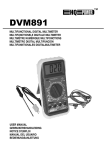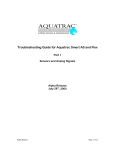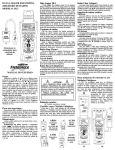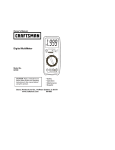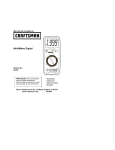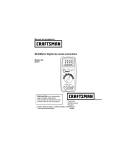Download Craftsman 82170 Owner`s manual
Transcript
Owner's Manual Digital MultiMeter Model No. 82170 CAUTION: Read, understand and follow Safety Rules and Operating Instructions in this manual before using this product. ! Safety ! Operation ! Maintenance ! Español Sears, Roebuck and Co., Hoffman Estates, IL 60179 www.craftsman.com 061606 TABLE OF CONTENTS Page 3 4 5 5 6 6 8 9 9 9 9 9 10 10 11 11 12 12 13 13 14 14 15 15 16 17 17 Warranty Safety Instructions Safety Symbols Control and Jacks Symbols and Annunciators Specifications Battery Installation Operating Instructions Data Hold Backlight Range Indicator Safety Shutters DC Voltage Measurements AC Voltage Measurements DC Current Measurements AC Current Measurements Resistance Measurements Continuity Check Diode Test Frequency Measurements Capacitance Measurements Temperature Measurements Maintenance Replacing Batteries Replacing Fuses Troubleshooting Service and Parts 2 ONE YEAR FULL WARRANTY ONE YEAR FULL WARRANTY ON CRAFTSMAN MANUAL RANGING MULTIMETER If this CRAFTSMAN Manual Ranging MultiMeter fails to give complete satisfaction within one year from the date of purchase, RETURN IT TO THE NEAREST SEARS STORE OR OTHER CRAFTSMAN OUTLET IN THE UNITED STATES, and Sears will replace it, free of charge. If this CRAFTSMAN Manual Ranging MultiMeter is used for commercial or rental purposes, this warranty applies for 90 days from the date of purchase. This warranty gives you specific legal rights, and you may also have other rights which vary from state to state Sears, Roebuck and Co., Dept. 817WA, Hoffman Estates, IL 60179 For Customer Assistance Call 9am-5 PM (EST) Monday through Friday 1-888-326-1006 WARNING: USE EXTREME CAUTION IN THE USE OF THIS DEVICE. Improper use of this device can result in injury or death. Follow all safeguards suggested in this manual in addition to the normal safety precautions used in working with electrical circuits. DO NOT service this device if you are not qualified to do so. 3 SAFETY INSTRUCTIONS This meter has been designed for safe use, but must be operated with caution. The rules listed below must be carefully followed for safe operation. 1. NEVER apply voltage or current to the meter that exceeds the specified maximum: Input Limits Function V DC 200mV range V DC/V AC >200mV ranges mA DC/AC 20A DC/AC Maximum Input 250V DC or AC 1000V DC or 700V AC 200mA DC/AC 20A DC/AC (30 seconds max every 15 minutes) 250V DC/AC Frequency, Resistance, Capacitance, Diode test, Continuity, Temperature 2. USE EXTREME CAUTION when working with high voltages. 3. DO NOT measure voltage if the voltage on the "COM" input jack exceeds 500V above earth ground. 4. NEVER connect the meter leads across a voltage source while the function switch is in the current, resistance, or diode mode. Doing so can damage the meter. 5. ALWAYS discharge filter capacitors in power supplies and disconnect the power when making resistance or diode tests. 6. ALWAYS turn off the power and disconnect the test leads before opening the doors to replace the fuse or batteries. 7. NEVER operate the meter unless the back cover and the battery and fuse doors are in place and fastened securely. 4 SAFETY SYMBOLS This symbol adjacent to another symbol, terminal or operating device indicates that the operator must refer to an explanation in the Operating Instructions to avoid personal injury or damage to the meter. WARNING This WARNING symbol indicates a potentially hazardous situation, which if not avoided, could result in death or serious injury. CAUTION This CAUTION symbol indicates a potentially hazardous situation, which if not avoided, may result damage to the product. MAX 500V This symbol advises the user that the terminal(s) so marked must not be connected to a circuit point at which the voltage with respect to earth ground exceeds (in this case) 500 VAC or VDC. This symbol adjacent to one or more terminals identifies them as being associated with ranges that may, in normal use, be subjected to particularly hazardous voltages. For maximum safety, the meter and its test leads should not be handled when these terminals are energized. Double Insulation CONTROLS AND JACKS 1. 2. 3. 4. 5. 6. 7. 8. 9. 2000 count Liquid Crystal Display Power switch Function Switch mA current input jack 20A current input jack Backlight pushbutton. Data Hold pushbutton Voltage, resistance capacitance and temperature positive input jack Common negative input jack 5 1 2 6 7 3 4 5 8 9 SYMBOLS AND ANNUNCIATORS H AC DC Continuity Low Battery Diode Data Hold Alternating Current or Voltage Direct Current or Voltage SPECIFICATIONS Function DC Voltage (V DC) Range 200mV 2V 20V 200V 1000V AC Voltage 2V (V AC) 20V (40 - 400Hz) 200V 700V DC Current 2mA (A DC) 20mA 200mA 20A AC Current 2mA (A AC) 200mA (40 - 400Hz) 20A Resistance 200$ 2k$ 20k$ 200k$ 2M$ 20M$ Resolution 0.1mV 1mV 10mV 100mV 1V 1mV 10mV 100mV 1V 1#A 10#A 100#A 10mA 1#A 100#A 10mA 0.1$ 1$ 10$ 100$ 1k$ 10k$ 6 Accuracy "(0.5% reading + 1 digit) "(0.5% reading + 3 digits) "(0.8% reading + 3 digits) "(1.0% reading + 5 digits "(1.2% reading + 5 digits "(1.0% reading + 3 digits) "(1.5% reading + 5 digits) "(2.0% reading + 10 digits) "(1.2% reading + 5 digits) "(2.0% reading + 5 digits) "(3.0% reading + 10 digits) "(1.0% reading + 10 digits) "(1.0% reading + 1 digit) "(1.0% reading + 5 digits) SPECIFICATIONS Function Range Resolution Accuracy Capacitance 2nF 1pF "(4.0% reading + 3 digits) 20nF 10pF 200nF 0.1nF 2µF 1nF 10nF 20#F Frequency 20kHz 10Hz "(1.5% reading + 10 digits) Sensitivity: 200mVac RMS to 10Vac RMS Temperature 0 to 32%F "(5.0% reading + 5 digits) 1%F 32 to 750%F "(1.0% reading + 3 digits) 760 to 1800%F "(2.0% reading + 3 digits) NOTE: Accuracy specifications consist of two elements: ! (% reading) – This is the accuracy of the measurement circuit. ! (+ digits) – This is the accuracy of the analog to digital converter. o o o o NOTE: Accuracy is stated at 64 F to 82 F (18 C to 28 C) and less than 75% RH ambient MultiMeter conditions. Diode Test Continuity Check Temperature sensor Input Impedance Display Overrange indication Polarity Measurement Rate Low Battery Indication Test current of approximately 1mA, open circuit voltage 2.8V DC typical Audible signal will sound if the resistance is less than approximately 40$, open circuit voltage 2.8V DC typical Type K temperature probe 10M$ (VDC and VAC) 2000 count LCD “1” is displayed Automatic (no indication for positive polarity); Minus (-) sign for negative polarity. 0.4 seconds, nominal “ ” is displayed if battery voltage drops below operating voltage 7 SPECIFICATIONS Batteries Fuses Operating Temperature Storage Temperature Relative Humidity Operating Altitude Weight Size Safety Requires one 9V NEDA 1604 or 6F22 battery (sold separately) mA range, 200mA/250V fast blow ceramic 20A range, 20A/250V fast blow o o o o 32 F to 104 F (0 C to 40 C) o o o o 10 F to 122 F (-10 C to 50 C) <70% operating 2000 meters (7000ft.) maximum. 12.34oz. (350g). 7.52” x 3.23” x 1.42” (191mm x 82mm x 36mm) For indoor use and in accordance with Overvoltage Category II, Pollution Degree 2. Category II includes local level, appliance, portable equipment, etc., with transient overvoltages less than Overvoltage Category III. BATTERY INSTALLATION WARNING: To avoid electric shock, disconnect the test leads from any source of voltage before removing the battery door. 1. Disconnect the test leads from the meter. 2. Open the battery door by lifting the rear stand and removing the two screws using a Phillips head screwdriver. 3. Insert the battery into battery holder, observing the correct polarity. 4. Put the battery door back in place. Secure with the two screws. WARNING: To avoid electric shock, do not operate the meter until the battery door is in place and fastened securely. NOTE: If your meter does not work properly, check the fuses and batteries to make sure that they are still good and that they are properly inserted. 8 OPERATING INSTRUCTIONS WARNING: Risk of electrocution. High-voltage circuits, both AC and DC, are very dangerous and should be measured with great care. 1. ALWAYS press the POWER switch to the OFF position when the meter is not in use. 2. If “1” appears in the display during a measurement, the value exceeds the range you have selected. Change to a higher range. NOTE: On some low AC and DC voltage ranges, with the test leads not connected to a device, the display may show a random, changing reading. This is normal and is caused by the high-input sensitivity. The reading will stabilize and give a proper measurement when connected to a circuit. DATA HOLD The Data Hold function allows the meter to "freeze" a measurement for later reference. 1. Press the DATA HOLD button to “freeze” the reading on the indicator. The indicator “ H “ will be appear in the display. 2. Press the DATA HOLD button to return to normal operation. BACKLIGHT The backlight function illuminates the display to improve readability in dimly lighted areas. 1. Press the “ “ button to turn the backlight on. 2. In order to conserve power, the backlight will automatically turn off after 5 seconds. RANGE INDICATOR The number below the decimal point in the LCD display indicates the full scale value of the range selected by the function switch. INPUT SHUTTERS The yellow input shutters either block or open the input jacks to insure proper test lead connections for the measurement function selected. 9 DC VOLTAGE MEASUREMENTS CAUTION: Do not measure DC voltages if a motor on the circuit is being switched ON or OFF. Large voltage surges may occur that can damage the meter. 1. Set the function switch to the highest V DC position. 2. Insert the black test lead banana plug into the negative (COM) jack. Insert the red test lead banana plug into the positive (V) jack. 3. Touch the black test probe tip to the negative side of the circuit. Touch the red test probe tip to the positive side of the circuit. 4. Read the voltage in the display. Reset the function switch to successively lower V DC positions to obtain a higher resolution reading. The display will indicate the proper decimal point and value. If the polarity is reversed, the display will show (-) minus before the value. AC VOLTAGE MEASUREMENTS WARNING: Risk of Electrocution. The probe tips may not be long enough to contact the live parts inside some 240V outlets for appliances because the contacts are recessed deep in the outlets. As a result, the reading may show 0 volts when the outlet actually has voltage on it. Make sure the probe tips are touching the metal contacts inside the outlet before assuming that no voltage is present. CAUTION: Do not measure AC voltages if a motor on the circuit is being switched ON or OFF. Large voltage surges may occur that can damage the meter. 1. Set the function switch to the highest V AC position. 2. Insert the black test lead banana plug into the negative (COM) jack. Insert red test lead banana plug into the positive (V) jack. 3. Touch the black test probe tip to the negative side of the circuit. Touch the red test probe tip to the positive side of the circuit. 4. Read the voltage in the display. Reset the function switch to successively lower V AC positions to obtain a higher resolution reading. The display will indicate the proper decimal point and value. 10 DC CURRENT MEASUREMENTS CAUTION: Do not make current measurements on the 20A scale for longer than 30 seconds. Exceeding 30 seconds may cause damage to the meter and/or the test leads. 1. Insert the black test lead banana plug into the negative (COM) jack. 2. For current measurements up to 200mA DC, set the function switch to the highest DC mA position and insert the red test lead banana plug into the (mA) jack. 3. For current measurements up to 20A DC, set the function switch to the 20A range and insert the red test lead banana plug into the (20A) jack. 4. Remove power from the circuit under test, then open up the circuit at the point where you wish to measure current. 5. Touch the black test probe tip to the negative side of the circuit. Touch the red test probe tip to the positive side of the circuit. 6. Apply power to the circuit. 7. Read the current in the display. For mA DC measurements, reset the function switch to successively lower mA DC positions to obtain a higher resolution reading. The display will indicate the proper decimal point and value. AC CURRENT MEASUREMENTS WARNING: To avoid electric shock, do not measure AC current on any circuit whose voltage exceeds 250V AC. CAUTION: Do not make current measurements on the 20A scale for longer than 30 seconds. Exceeding 30 seconds may cause damage to the meter and/or the test leads. 1. Insert the black test lead banana plug into the negative (COM) jack. 2. For current measurements up to 200mA AC, set the function switch to the highest AC mA position and insert the red test lead banana plug into the (mA) jack. 3. For current measurements up to 20A AC, set the function switch to the 20A range and insert the red test lead banana plug into the (20A) jack. 11 4. Remove power from the circuit under test, then open up the circuit at the point where you wish to measure current. 5. Touch the black test probe tip to the negative side of the circuit. Touch the red test probe tip to the positive side of the circuit. 6. Apply power to the circuit. 7. Read the current in the display. For mA AC measurements, reset the function switch to successively lower mA AC positions to obtain a higher resolution reading. The display will indicate the proper decimal point and value. RESISTANCE MEASUREMENTS WARNING: To avoid electric shock, disconnect power to the unit under test and discharge all capacitors before taking any resistance measurements. Remove the batteries and unplug the line cords. 1. Set the function switch to the highest $& position. 2. Insert the black test lead banana plug into the negative (COM) jack Insert the red test lead banana plug into the positive $ jack. 3. Touch the test probe tips across the circuit or part under test. It is best to disconnect one side of the part under test so the rest of the circuit will not interfere with the resistance reading. 4. Read the resistance in the display and then set the function switch to the lowest $ position that is greater than the actual or any anticipated resistance. The display will indicate the proper decimal point and value. CONTINUITY CHECK WARNING: To avoid electric shock, never measure continuity on circuits or wires that have voltage on them. 1. Set the function switch to the position. 2. Insert the black lead banana plug into the negative (COM) jack Insert the red test lead banana plug into the positive ($) jack. 3. Touch the test probe tips to the circuit or wire you wish to check. 4. If the resistance is less than approximately 40$, the audible signal will sound. If the circuit is open, the display will indicate “1”. 12 DIODE TEST WARNING: To avoid electric shock, do not test any diode that has voltage on it. 1. Set the function switch to position. 2. Insert the black test lead banana plug into the negative (COM) jack. Insert the red test lead banana plug into the positive (V) jack. 3. Touch the test probe tips to the diode or semiconductor junction you wish to test. Note the meter reading. 4. Reverse the probe polarity by switching probe position. Note this reading. 5. The diode or junction can be evaluated as follows: A. If one reading shows a value and the other reading shows “1”, the diode is good. B. If both readings show “1”, the device is open. C. If both readings are very small or 0, the device is shorted. NOTE: The value indicated in the display during the diode check is the forward voltage. FREQUENCY MEASUREMENT 1. Set the function switch to the FREQ position. 2. Insert the black test lead banana plug into the negative (COM) jack. Insert the red test lead banana plug into the positive (V/$) jack. 3. Touch the black test probe tip to the negative side of the circuit. Touch the red test probe tip to the positive side of the circuit. 4. Read the frequency in the display. The digital reading will indicate the proper decimal point, and value. 13 CAPACITANCE MEASUREMENTS WARNING: To avoid electric shock, disconnect power to the unit under test and discharge all capacitors before taking any capacitance measurements. Remove the batteries and unplug the line cords. 1. Set the function switch to the highest CAP position. 2. Insert the black test lead banana plug into the negative (COM) jack. Insert the red test lead banana plug into the positive (CAP) jack. 3. Touch the test leads to the capacitor to be tested. 4. Read the capacitance in the display and then set the function switch to the lowest CAP position that is greater than the actual or any anticipated capacitance The display will indicate the proper decimal point and value. TEMPERATURE MEASUREMENTS WARNING: To avoid electric shock, disconnect both test probes from any source of voltage before making a temperature measurement. 1. Set the function switch to a TEMP position. 2. Insert the Temperature Probe into the negative (COM) and the positive (TEMP) jacks, making sure to observe the correct polarity. 3. Touch the Temperature Probe head to the part whose temperature you wish to measure. Keep the probe touching the part under test until the reading stabilizes (about 30 seconds). 4. Read the temperature in the display. The digital reading will indicate the proper decimal point and value. WARNING: To avoid electric shock, be sure the thermocouple has been removed before changing to another measurement function. 14 MAINTENANCE WARNING: To avoid electric shock, disconnect the test leads from any source of voltage before removing the back cover or the battery or fuse doors. WARNING: To avoid electric shock, do not operate your meter until the battery and fuse doors are in place and fastened securely. This MultiMeter is designed to provide years of dependable service, if the following care instructions are performed: 1. KEEP THE METER DRY. If it gets wet, wipe it off. 2. USE AND STORE THE METER IN NORMAL TEMPERATURES. Temperature extremes can shorten the life of the electronic parts and distort or melt plastic parts. 3. HANDLE THE METER GENTLY AND CAREFULLY. Dropping it can damage the electronic parts or the case. 4. KEEP THE METER CLEAN. Wipe the case occasionally with a damp cloth. DO NOT use chemicals, cleaning solvents, or detergents. 5. USE ONLY FRESH BATTERIES OF THE RECOMMENDED SIZE AND TYPE. Remove old or weak batteries so they do not leak and damage the unit. 6. IF THE METER IS TO BE STORED FOR A LONG PERIOD OF TIME, the batteries should be removed to prevent damage to the unit. REPLACING THE BATTERY WARNING: To avoid electric shock, disconnect the test leads from any source of voltage before removing the battery door. 1. When the battery become exhausted or drops below the operating voltage, “ ” will appear in the LCD display. The battery should be replaced. 2. Follow instructions for installing batteries. See the Battery Installation section of this manual. 3. Dispose of the old batteries properly. 15 WARNING: To avoid electric shock, do not operate your meter until the battery door is in place and fastened securely. REPLACING THE FUSES WARNING: To avoid electric shock, disconnect the test leads from any source of voltage before removing the fuse door. 1. Disconnect the test leads from the meter and any item under test. 2. Remove the protective holster and then remove the three screws and lift off the back cover. 3. Remove the old fuse from its holder by gently pulling it out. 4. Install the new fuse into the holder. 5. Always use a fuse of the proper size and value. 6. Replace the rear cover and secure it with the three screws. WARNING: To avoid electric shock, do not operate your meter until the fuse door is in place and fastened securely. UL LISTED The UL mark does not indicate that this product has been evaluated for the accuracy of its readings. 16 TROUBLESHOOTING There may be times when your meter does not operate properly. Here are some common problems that you may have and some easy solutions to them. Meter Does Not Operate: 1. Always read all the instructions in this manual before use. 2. Check to be sure the battery is properly installed. 3. Check to be sure the battery is good. 4. If the battery is good and the meter still does not operate, check to be sure that both ends of the fuse are properly installed. If You Do Not Understand How the Meter Works: 1. Purchase the instructional book “Multitesters and Their Use for Electrical Testing” (Item No. 82303) at your local Sears store. 2. Call our Customer Service Line 1-888-326-1006. SERVICE AND PARTS Item Number 82375 93894 82378 82170-DB 82170-CS 82394 Description Fuse kit 9V Battery Set of black and red Test Leads Replacement battery door Rear cover screws Type k temperature probe For replacement parts shipped directly to your home Call 9 am – 5 pm Eastern Time, M - F 1-888-326-1006 17

















